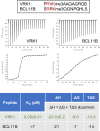Histone H3 N-terminal mimicry drives a novel network of methyl-effector interactions
- PMID: 33969871
- PMCID: PMC8166343
- DOI: 10.1042/BCJ20210203
Histone H3 N-terminal mimicry drives a novel network of methyl-effector interactions
Abstract
The reader ability of PHD fingers is largely limited to the recognition of the histone H3 N-terminal tail. Distinct subsets of PHDs bind either H3K4me3 (a transcriptional activator mark) or H3K4me0 (a transcriptional repressor state). Structural studies have identified common features among the different H3K4me3 effector PHDs, including (1) removal of the initiator methionine residue of H3 to prevent steric interference, (2) a groove where arginine-2 binds, and (3) an aromatic cage that engages methylated lysine-4. We hypothesize that some PHDs might have the ability to engage with non-histone ligands, as long as they adhere to these three rules. A search of the human proteome revealed an enrichment of chromatin-binding proteins that met these criteria, which we termed H3 N-terminal mimicry proteins (H3TMs). Seven H3TMs were selected, and used to screen a protein domain microarray for potential effector domains, and they all had the ability to bind H3K4me3-interacting effector domains. Furthermore, the binding affinity between the VRK1 peptide and the PHD domain of PHF2 is ∼3-fold stronger than that of PHF2 and H3K4me3 interaction. The crystal structure of PHF2 PHD finger bound with VRK1 K4me3 peptide provides a molecular basis for stronger binding of VRK1 peptide. In addition, a number of the H3TMs peptides, in their unmethylated form, interact with NuRD transcriptional repressor complex. Our findings provide in vitro evidence that methylation of H3TMs can promote interactions with PHD and Tudor domain-containing proteins and potentially block interactions with the NuRD complex. We propose that these interactions can occur in vivo as well.
Keywords: NuRD complex; PHD domain; PHF2; Tudor domain; VRK1.
© 2021 The Author(s).
Conflict of interest statement
M.T.B. is a co-founder of EpiCypher.
Figures







Similar articles
-
A complete methyl-lysine binding aromatic cage constructed by two domains of PHF2.J Biol Chem. 2023 Feb;299(2):102862. doi: 10.1016/j.jbc.2022.102862. Epub 2022 Dec 31. J Biol Chem. 2023. PMID: 36596360 Free PMC article.
-
Characterization of the plant homeodomain (PHD) reader family for their histone tail interactions.Epigenetics Chromatin. 2020 Jan 24;13(1):3. doi: 10.1186/s13072-020-0328-z. Epigenetics Chromatin. 2020. PMID: 31980037 Free PMC article.
-
Plant homeodomain (PHD) fingers of CHD4 are histone H3-binding modules with preference for unmodified H3K4 and methylated H3K9.J Biol Chem. 2011 Apr 1;286(13):11779-91. doi: 10.1074/jbc.M110.208207. Epub 2011 Jan 28. J Biol Chem. 2011. PMID: 21278251 Free PMC article.
-
Structural insight into histone recognition by the ING PHD fingers.Curr Drug Targets. 2009 May;10(5):432-41. doi: 10.2174/138945009788185040. Curr Drug Targets. 2009. PMID: 19442115 Free PMC article. Review.
-
Plant homeodomain fingers form a helping hand for transcription.Epigenetics. 2011 Jan;6(1):4-8. doi: 10.4161/epi.6.1.13297. Epub 2011 Jan 1. Epigenetics. 2011. PMID: 20818169 Free PMC article. Review.
Cited by
-
Molecular convergence by differential domain acquisition is a hallmark of chromosomal passenger complex evolution.Proc Natl Acad Sci U S A. 2022 Oct 18;119(42):e2200108119. doi: 10.1073/pnas.2200108119. Epub 2022 Oct 13. Proc Natl Acad Sci U S A. 2022. PMID: 36227914 Free PMC article.
-
Involvement of the H3.3 Histone Variant in the Epigenetic Regulation of Gene Expression in the Nervous System, in Both Physiological and Pathological Conditions.Int J Mol Sci. 2023 Jul 3;24(13):11028. doi: 10.3390/ijms241311028. Int J Mol Sci. 2023. PMID: 37446205 Free PMC article. Review.
-
The pattern of histone H3 epigenetic posttranslational modifications is regulated by the VRK1 chromatin kinase.Epigenetics Chromatin. 2023 May 13;16(1):18. doi: 10.1186/s13072-023-00494-7. Epigenetics Chromatin. 2023. PMID: 37179361 Free PMC article.
-
Histone mimics: more tales to read.Biochem J. 2021 Jul 30;478(14):2789-2791. doi: 10.1042/BCJ20210357. Biochem J. 2021. PMID: 34297041 Free PMC article.
-
The interplay between viral molecular mimicry and host chromatin dynamics.Nucleus. 2023 Dec;14(1):2216560. doi: 10.1080/19491034.2023.2216560. Nucleus. 2023. PMID: 37218181 Free PMC article. Review.
References
Publication types
MeSH terms
Substances
Grants and funding
LinkOut - more resources
Full Text Sources
Other Literature Sources
Miscellaneous

